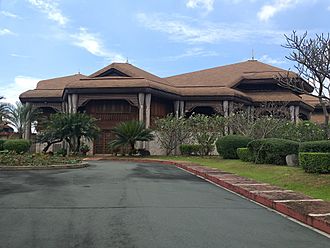Coconut Palace facts for kids
Quick facts for kids Coconut Palace |
|
|---|---|
|
Tahanang Pilipino
|
|

The Coconut Palace
|
|
| General information | |
| Architectural style | Filipino vernacular architecture |
| Address | F. Ma. Guerrero Street |
| Town or city | Manila |
| Country | Philippines |
| Coordinates | 14°33′19″N 120°58′48″E / 14.55522°N 120.980013°E |
| Completed | 1978 |
| Renovated | 2010 |
| Design and construction | |
| Architect | Francisco Mañosa |
The Coconut Palace, also known as Tahanang Pilipino (meaning Filipino Home), is a special government building. It is located in the Cultural Center of the Philippines Complex in Manila, Philippines. For a time, it served as the official home and office for the Vice President of the Philippines, Jejomar Binay.
This unique palace was built in 1978. It was ordered by the First Lady of the Philippines at the time, Imelda Marcos. She wanted it to be a guest house for important visitors. In 1981, it was offered to Pope John Paul II during his visit. However, the Pope chose not to stay there, preferring simpler accommodations.
The Coconut Palace cost about ₱37 million to build. Part of the money came from a fund meant to help coconut farmers. Today, the Government Service Insurance System (GSIS) owns the building.
The palace is truly a celebration of the coconut tree. It is made from different kinds of Philippine hardwood, coconut shells, and a special type of coconut lumber. Each guest room on the second floor is named after a region of the Philippines. These rooms also show off beautiful handicrafts from those regions.
The Coconut Palace is found on F. Ma. Guerrero Street. It sits within the Cultural Center of the Philippines Complex. It is located between the Folk Arts Theatre and the Sofitel Philippine Plaza Hotel. Besides being a Vice President's residence, it has also been a popular place for weddings.
Contents
Unique Design and Features
The Coconut Palace has a very interesting shape. It looks like an octagon, which is similar to a fresh coconut cut open. Its roof is shaped like a traditional Filipino hat called a salakót.
Inside, you can see many amazing details. There is a chandelier made from 101 coconut shells. The dining table is also special, with 40,000 tiny pieces of inlaid coconut shell. The palace is known as one of the most striking buildings in the Cultural Center of the Philippines. Its design shows how important the coconut, often called the "tree of life", is to the Philippines. Every part of the coconut, from its roots to its fruit, is reflected in the palace's design.
Famous Visitors and TV Appearances
Over the years, the Coconut Palace has hosted many important guests. These included the former leader of Libya, Muammar al-Gaddafi, and famous actors like Brooke Shields and George Hamilton.
The palace has also been featured on television. In the fifth season of the reality show The Amazing Race, it was a "Pit Stop" when teams visited Manila. The contestants were greeted by Luli Arroyo, who is the daughter of a former President. The palace was also used as a filming location for the ABS-CBN TV series Princess Sarah and Tanging Yaman. In Tanging Yaman, it stood in for Malacañang Palace, the official residence of the President.
Becoming the Vice President's Home
The Coconut Palace received major updates and renovations. This was because it was being considered as the official office and home for the Vice President. On February 11, 2011, it was officially given to Vice President Jejomar Binay. This happened after a lease agreement was signed with the Government Service Insurance System (GSIS). The monthly rent for the palace was ₱400,000.
Guest Rooms of the Palace
The palace has seven guest rooms, each named after a Philippine province. These rooms showcase the unique culture and art of each region:
- Zamboanga Room: This was the first room and was a favorite of actor George Hamilton.
- Pampanga Room: It displays art from the Pampanga region, including statues made from lahar (volcanic mudflow) from Mount Pinatubo.
- Marawi Room: This room highlights the rich Muslim culture of Mindanao.
- Bicol Room: This was a favorite room of First Lady Imelda Marcos.
- Mountain Province Room: It contains many traditional items from the Cordillera tribes.
- Iloilo Room
- Pangasinan Room: This room was used by former President Ferdinand Marcos.
Images for kids
See also
 In Spanish: Palacio del Coco para niños
In Spanish: Palacio del Coco para niños
- Malacañan Palace, the official residence of the Philippine President


